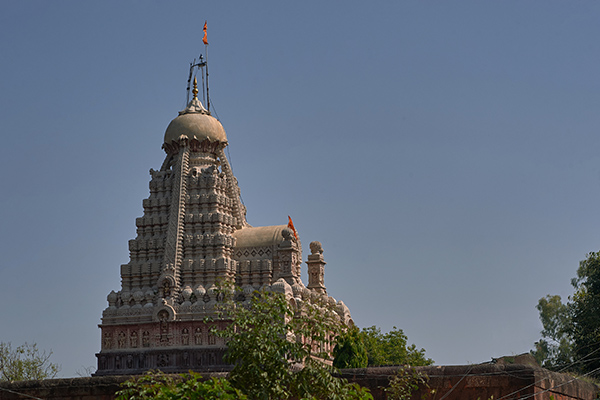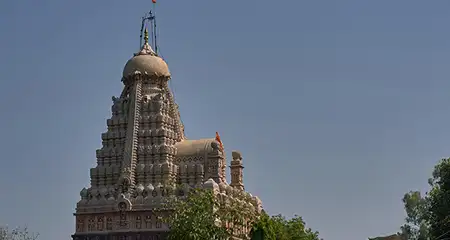Grishneshwar Temple dedicated to Lord Shiva is one of the holiest Hindu pilgrimage sites in India. Located about 35 km away from the city of Aurangabad and about 2 km away from the UNESCO-listed Ellora Caves, it is home to the 12th and the last Jyotirlinga on earth. It is an ancient shrine that finds mention in the Shiva Purana, one of the sacred scriptures in Hinduism. The temple, which is believed to have been built in the 13th century, was repeatedly destroyed and rebuilt during the reign of the Mughals, and was rebuilt in its present form in the 18th century. Today, the temple serves not just as a religious site but also as a key attraction in Maharashtra tourism, especially for travelers visiting the Ellora Caves.
If you are planning your Aurangabad itinerary, keep aside some time to explore this historical temple. From its history, timings, architecture to entry fee, nearby attractions, and lesser-known facts, here’s everything you need to know about the Grishneshwar Temple.
Grishneshwar Temple, Aurangabad Information
| Location | Verul, Aurangabad District |
| Also Known as | Ghrneshwar, Dhushmeshwar Temple, and Grishneshwar Jyotirlinga Temple |
| Type | Hindu Temple |
| Status | The 12th Jyotirlinga |
| Dedicated to | Grishneshwar, a manifestation of Lord Shiva |
| Timings | 5:30 am to 11:00 pm every day; 3:00 am to 11:00 pm during the month of Shravan (August-September) |
| Entry Fee | No entry fee |
| Still Cameras, Video Cameras, Mobile Phones | Not allowed inside the temple |
| Distance from Major Transportation Hubs | Aurangabad Airport (41 km); Aurangabad Railway Station (34 km) |
| Origins of the Temple | Before the 13th century |
| Current Structure Constructed in | 18th century |
| Current Structure Constructed by | Rani Ahilyabai Holkar of Indore |
| Architectural Style | South Indian temple architecture |
| Material Used | Red rocks |
| Transportation Options | MSRTC buses plying between Aurangabad and Ellora and private taxis |
Grishneshwar Temple, Aurangabad: History
While no historical record specifies its actual date of construction, it is generally believed that the temple has its origins before the 13th century. During the 13th and 14th centuries, the temple faced repeated destruction under the rule of the Delhi Sultanate. It was rebuilt in the 16th century by Maloji Bhosale who was the grandfather of Chhatrapati Shivaji Maharaj. The temple suffered attacks even after this. Rani Ahilyabai Holkar of Indore rebuilt the current temple structure in the 18th century after the downfall of the Mughal Empire.
Grishneshwar Temple, Aurangabad: Architecture
Constructed in the traditional South Indian temple architectural style, the Grishneshwar Temple exhibits an elaborately designed five-tier shikhara. The temple complex comprises a sanctum sanctorum, which is a square room measuring about 289 square feet, and inner chambers.
Built out of red stones, the temple measures 240 feet x 185 feet, which makes it the smallest of all the 12 Jyotirlingas in India. Adorning the temple complex is a court hall and a sculpture of Nandi, Lord Shiva’s bull. Carved images of Lord Shiva and Lord Vishnu can also be seen in the temple. The shrine houses the revered Shiva Linga that faces eastward.
Grishneshwar Temple, Aurangabad: Today
Today, the Grishneshwar Temple is a major destination for tourists visiting Aurangabad and a pilgrimage site for Shiva devotees. While anyone can enter the inner chambers of the temple to seek blessings from the deity, tradition requires that men enter the sanctum sanctorum bare-chested. Every year, the temple celebrates the festival of Mahashivratri in honor of Lord Shiva, during which it witnesses a heavy footfall.
Things to See in the Grishneshwar Temple Complex, Aurangabad
The temple complex has several attractions that draw the attention of visitors. These include:
- The elaborate temple structure with its intricately designed five-tier shikhara.
- The sacred Shiva Linga, which is one of the 12 Jyotirlingas in India.
- The court hall supported by 24 pillars, each of which is carved with images from mythological stories associated with Lord Shiva.
- The Dashavataras or the ten forms of Vishnu depicted on red stones.
- Sculptures and carvings of several Hindu Gods and Goddesses adorning the temple complex.
Lesser-known Facts about Grishneshwar Temple, Aurangabad
- The term Grishneshwar means the lord of compassion. Shiva is worshipped here as the Lord of Compassion who is believed to take away all the sufferings of his devotees.
- Devotees of Lord Shiva believe that the act of worshipping this Jyotirlinga equals to worshipping all other Jyotirlingas.
- According to the Skand Puran, once Lord Shiva came to this temple after getting upset with Devi Parvati. So, she too came to this temple in the form of a tribal girl to worship the Lord.
- Grishneshwar Temple is one of those very few shrines in India where the Shiva Linga faces the east.
- Devotees regard Shivalay Sarovar, a lake located near the temple, as a holy water body.
- No yajnas or ritual sacrifices are performed in this temple since it represents Agni Tattva, one of the five fundamental forces of nature as per Hinduism.
- Besides the Grishneshwar Temple, there are two more Jyotirlingas in Maharashtra, namely Bhimashankar (near Pune) and Trimbakeshwar (Nashik).
Attractions near Grishneshwar Temple, Aurangabad
- Ellora Digamber Jain Temple (600 m)
- Ellora Caves (2 km)
- Tomb of Malik Ambar (6 km)
- Bhadra Maruti Temple (6 km)
- Tomb of Aurangzeb (6 km)
- Mughal Silk Bazaar (7 km)
- Daulatabad Fort (15 km)
Besides these places, you can visit other major tourist attractions in and around Aurangabad city such as Bibi Ka Maqbara, Soneri Mahal, Aurangabad Caves, Himayat Bagh, etc., all of which are located over 30 km from the temple.
The serene ambiance of the historical Grishneshwar Temple makes it a favorite with nirvana seekers and tourists alike. While in the area, keep aside some time to explore the famous Ellora Caves, which tops the list of places to visit near Aurangabad within 100 km. So, let’s start planning a weekend trip, shall we?

























